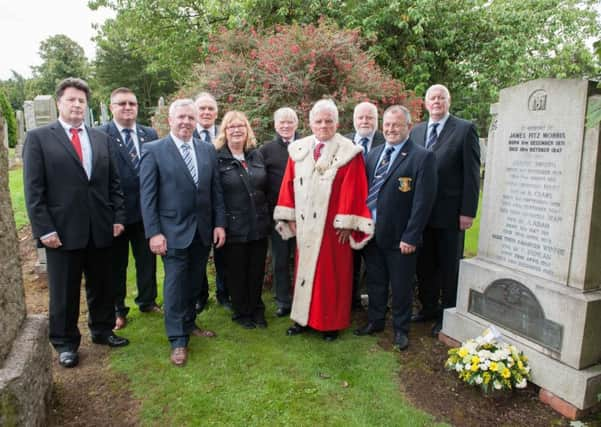Remembering Polmont's flying ace


The former Laurieston School pupil accounted for 14 enemy planes during the conflict, earning himself a Military Cross for his efforts, and was stationed in the USA near the end of the war to serve as an instructor for American pilots.
Sadly, after having triumphed over The Red Baron and his Flying Circus, Captain Fitz-Morris was killed when his Sopwith Camel crashed shortly after take off at the Western Hills Golf Course in Cincinnati, Ohio on August 14, 1918.
He was just 21-years-old.
Advertisement
Hide AdAdvertisement
Hide AdLast week Falkirk Provost Billy Buchanan and guests remembered Captain Fitz-Morris with a short ceremony at his grave in the grounds of Polmont Old Church on the 100th anniversary of his death.
Provost Buchanan, who laid a wreath at the grave, said: “He was only 21 when he died but his service to his King and country was spectacular. This young man will be remembered by those who have enjoyed the benefits of the freedom he and his comrades died for.
“We must never weary in remembering.”
Born and raised in Polmont, James Fitz-Morris was heading for a high-flying career in the civil service, before the First World War started and he answered the call to serve his country.
The youngster actually joined up with the army in 1914 – in the understanding his post with the civil service would be waiting for him on his return. He served in the Highland Light Infantry as a motor despatch rider, but transferred to the Royal Flying Corps after only three months.
Advertisement
Hide AdAdvertisement
Hide AdInitially training as an observer, he flew in the Vickers Gunbus with Number 11 Squadron in 1915 before retraining as a pilot.
The ace-in-waiting was appointed as a flying officer with the rank of temporary second lieutenant on July 12, 1916.
His operational career as a pilot got off to a bumpy start – literally – when he was injured in a flying accident in August 1916 while serving with Number 11 Squadron, fracturing his nose and suffering a concussion.
While recovering he began his first stint as an instructor at Harlaxton in Lincolnshire and was promoted to captain.
Advertisement
Hide AdAdvertisement
Hide AdWhen he was fit enough to return, Captain Fitz-Morris joined Number 25 Squadron in France in July 1917, flying the Royal Aircraft Factory FE.2d and then the Airco DG.4 bomber, shooting down, with his gunner David Luther, seven aircraft between July and August to earn themselves prestigious Military Cross medals.
Captain Fitz-Morris became flight commander of Number 23 Squadron, flying the French-made SPAD aircraft from early 1918 onward, and winning a bar to his Military Cross by downing another seven aircraft during March 1918.
During his final dogfight of that month, Captain Fitz-morris was wounded and grounded for a few days. He flew again, but did not account for any more enemy planes in the remainder of his active service.
Captain Fitz-Morris spent the rest of the First World War in America with the British Aviation Mission, serving under Brigadier-General Charlies Frederick Lee. While working as an instructor, he took part on a barnstorming tour of the mid-Western states which was designed to drum up support for the war effort, and specifically the air services.
Advertisement
Hide AdAdvertisement
Hide AdIt was during this tour and a stopover in Ohio the air ace took off in a Sopwith Camel only to crash a short time later.
The Decatur Review reported: “What promised to be a gala day for a number of American aviators from the aviation field at Dayton ended in gloom late Wednesday afternoon when Captain James Fitz-Morris, of the British Royal Flying Corps, was killed just west of Cincinnati. His engine suddenly died and the plane plunged to the ground killing Fitz-Morris instantly.”
Captain Fitz-Morris was temporarily laid to rest in Cincinnati after a funeral attended by 4000 mourners, with around 250,000 more lining the route.
A year later, after the war was over, the heroic flying ace’s remains were repatriated and re-interred at Polmont Old Churchyard.